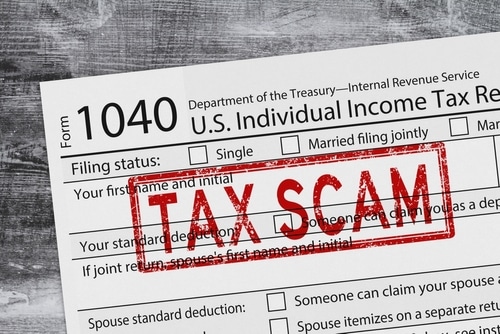Key Highlights
- Tax scams are schemes designed to steal money and personal information from victims.
- These scams often involve impersonating the IRS or tax professionals through various methods.
- Common tactics include phishing emails, fake tax preparers, and fake tax deductible charities.
- Falling victim to a tax scam can lead to significant financial losses and emotional pain.
- Protecting yourself involves being vigilant, verifying communications, and relying on trusted sources for tax advice.
Scam activity heightens during tax season but can occur year-round. Scammers impersonate trusted entities like the IRS, tax professionals, or charity organizations tricking individuals into sending money or disclosing personal and financial information. These imposters use convincing tactics such as official-looking websites, fake caller IDs displaying “ IRS”, and even AI generated voices or messages to appear legitimate.
Common scam tactics include: fake tax deductible charity donations, fake advanced fee refunds or special tax credits, and fake unpaid tax claims to name a few.
Understanding Tax Scams in the Digital Age
With the rise of technology, scams have changed a lot. Scammers are no longer using just old ways to operate. They now use modern methods to trick people into giving away their sensitive financial information.
The evolution of tax scams with technology
The digital age is creating more elaborate tax scams. Scammers are using technology to create smarter schemes. Social media is a big part of our lives and unfortunately is a hotbed for these scams to grow.
Scammers use social media platforms to target victims quickly and hide their real identity, making it hard to know what advice is genuine and what is a scam. They also use social engineering tricks to manipulate victims into trusting them and giving away sensitive information. They might pretend to be authority figures or create a false sense of urgency. Sometimes, they even play with people’s emotions to get past logical thinking.
As technology changes, it is very important for taxpayers to stay alert and learn about the latest scams. Recognizing warning signs and being careful with unsolicited requests is key to protecting yourself from these scams.
Recognizing the Most Common Tax Scams
As technology changes, tax scams have gotten more complex. This makes it harder to tell what is real and what is fake. It’s very important to know about common tax scams. This knowledge helps protect your personal information and finances.
Scams can come in many forms including phishing emails or fake tax preparers. They aim to take advantage of innocent taxpayers, particularly targeting older adults given their higher savings and Social Security benefits.
Let’s look at some of the most common tax scams happening today.
Phishing emails and smishing texts
Scammers often employ phishing and smishing tactics by sending fraudulent emails or text messages that appear to originate from the IRS or other legitimate tax authorities. These communications typically prompt recipients to click on malicious links, provide personal information, or download harmful software. Scammers may use language such as ‘Your account is on hold’, ‘Unusual activity report’, or ‘ Information needed for tax refund’ to lure victims.
Here are some signs that a message may be a scam attempt:
- Misspellings, grammar mistakes, or strange wording
- Threats of legal action or penalties
- Immense urgency and pressure to act
- Demand for quick payment through odd methods like gift cards
- Links to strange or suspicious websites
Fake advanced- fee scams
Fake advanced-fee tax scams involve scammers promising large tax refunds, tax debt relief, or stimulus payments in exchange for upfront fees or personal information. Scammers will mislead victims into believing they are eligible and often target via social media. They may pose as tax preparers or IRS agents and ask for payment in advance to “secure”, “process”, or “expedite” the refund. Once victims pay, the recipient disappears.
Fake tax deductible charity scams
In the wake of natural disasters or during charitable giving seasons, scammers often create fake charities to exploit the generosity of taxpayers. They solicit donations, claiming that contributions are tax-deductible, while in reality, the funds are misappropriated. Scammers use tactics like pressuring and guilting victims to make an ‘urgent’ donation. Once victims pay, the recipient disappears. The IRS warns taxpayers to be cautious and recommends verifying the legitimacy of charities through tools like the IRS’s Tax Exempt Organization Search Tool. Falling for such scams not only results in financial loss but also deprives legitimate charities of much-needed support.

Consequences of Tax Scams
Becoming a victim of a tax scam can be seriously harmful in many ways, not just financially. In addition to draining your bank account, these scams can take a toll on your emotional well-being. The risks highlight the importance of staying alert and taking steps to protect yourself.
Financial repercussions for individuals
The financial impact of a tax scam can be serious. These losses can be large and sometimes cannot be completely recovered. This can create a heavy load on a person’s finances.
To protect yourself, it’s important to keep your sensitive information and money safe. This includes your Social Security number, bank account details, log in information, and one time passwords. Be careful about who you share this information with and be careful to whom you send money. Always stay alert for any suspicious activity to help protect your financial health.
How You Can Protect Yourself From Tax Scams
- Be suspicious of unexpected communications: Scammers frequently use unsolicited emails, text messages, or social media messages claiming to be the IRS or a tax professional.
- Be on alert for these messages: Threats of arrest or legal action, “looks too good to be true” refund offers, and urgent claims that your account needs assistance. Poor grammar, spelling errors, or odd formatting is a clear tip off.
- Reflect on the payment method: Scammers often demand payment to be sent via gift cards, money transfer apps, or cryptocurrency. Always visit the official tax office website to verify payment procedures, and use a URL checker to ensure you’re not being directed to a fraudulent site.
- Verify the legitimacy of a tax professional with the IRS’s Directory of Federal Tax Return Preparers and the legitimacy of a charity with the IRS’s Tax-Exempt Organization Search (TEOS) Tool.
- Don’t rush, ask for help: Scammers rely on pressure tactics. If something feels off, pause, reflect, and consider consulting a trusted family member or friend before responding or sharing any information.
Sources
Staying updated on current trends and tricks used by scam artists is very important for your safety. The IRS has many resources to help taxpayers understand potential threats and give advice on safe practices. Their website often shares news about new scams and offers helpful tips on how to spot fraud.
News outlets regularly report on tax scams. They share stories from victims and advice from cybersecurity experts. By following trusted news sources, you can get useful information on new tactics that scammers use. This helps you stay alert to threats and keep your finances safe.
